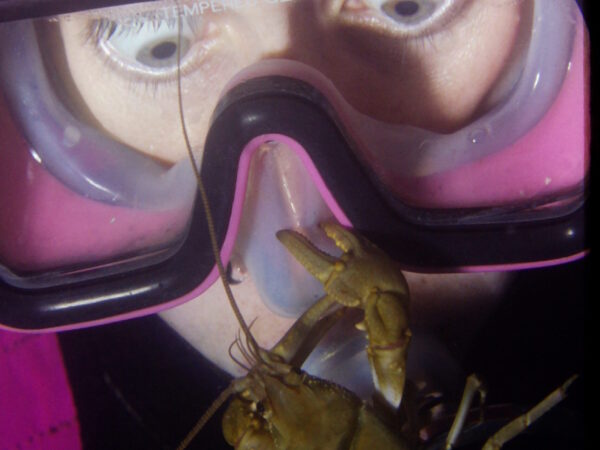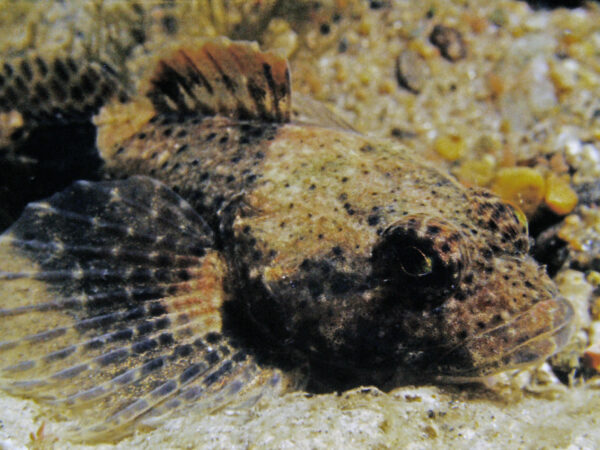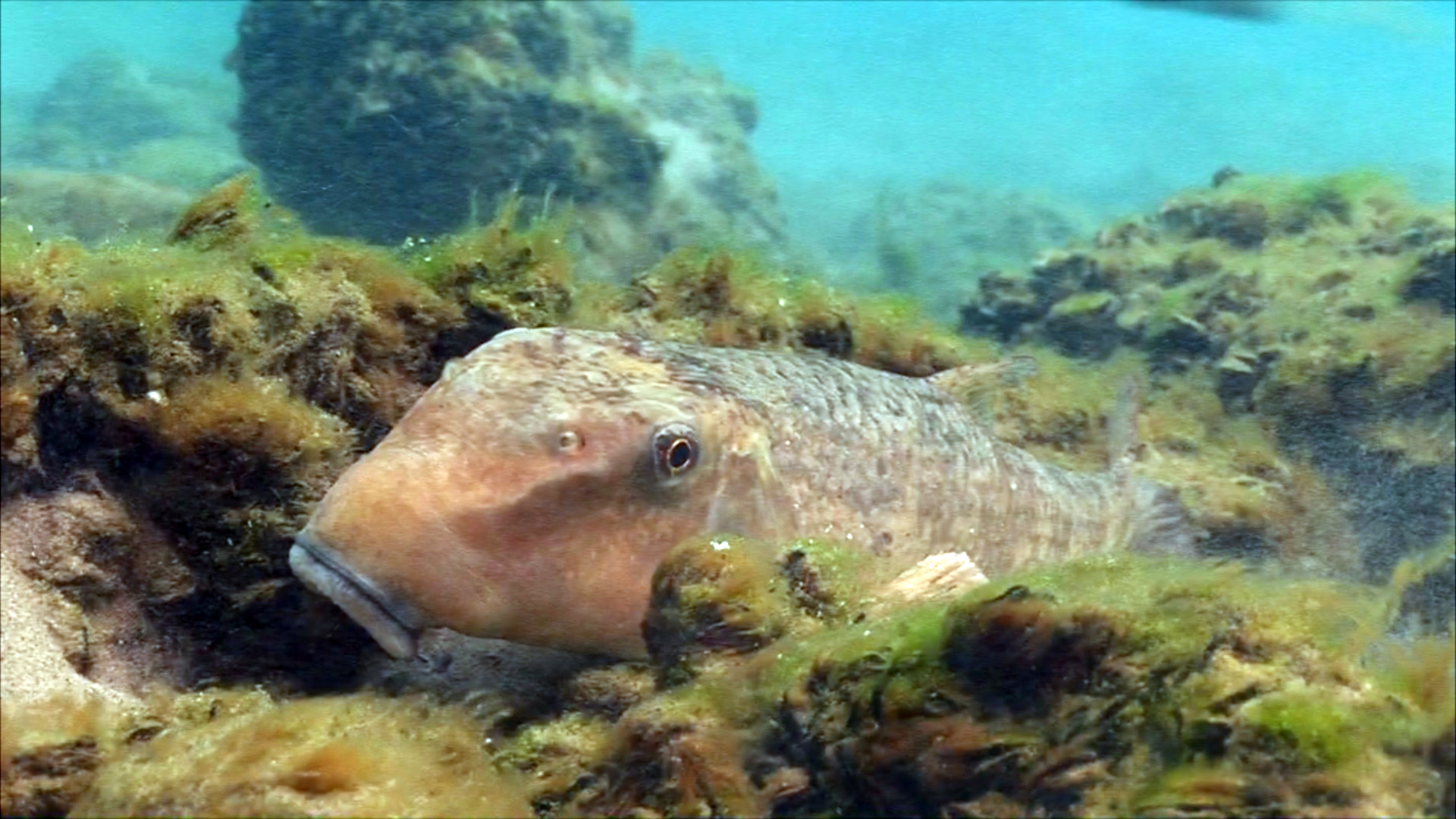
 I Speak for the Fish is a monthly column written by Great Lakes Now Contributor Kathy Johnson, coming out the third Monday of each month. Publishing the author’s views and assertions does not represent endorsement by Great Lakes Now or Detroit Public Television. Check out her previous columns.
I Speak for the Fish is a monthly column written by Great Lakes Now Contributor Kathy Johnson, coming out the third Monday of each month. Publishing the author’s views and assertions does not represent endorsement by Great Lakes Now or Detroit Public Television. Check out her previous columns.
I can’t keep my suckers straight.
There are over a dozen species of sucker living in the Great Lakes region. Of those, I can only confidently identify two underwater. I can make a fairly accurate guess with maybe one more.
Northern hog suckers are somewhat rare to see but when I do spot one, it’s unmistakable. Unlike most suckers, hogs lay motionless on the river bottom. Like giant sculpin, the hog suckers’ mottled coloring provides perfect camouflage amongst the gravel and sand on the bottom.
I usually only see them when they are directly in front of me on a downstream drift. Depending on my trajectory, they will only move to avoid a head-on collision. Normally they remain motionless and merely roll their eyes at me as I fly past.
In the spring, when white suckers are spawning, I can confidently identify them due to the solid black stripe that appears down their sides. The rest of the year, it’s a marginally educated guess.
There are six kinds of redhorse sucker: black, golden, greater, river, shorthead, and silver. I’d be hard pressed to match most of those names with a picture of the fish.
Thankfully, the shorthead redhorse I see most often are easily identified by the rim of bright red on their tails.
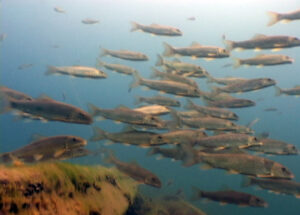
School of White Suckers. (Photo Credit: Greg Lashbrook/PolkaDot Perch)
Scarlet O’Horse
Redhorse suckers get their name, in part, from the color on their tails, which ranges from pale rose to dark scarlet. Their faces are broad and flat much like a horse’s and their large puffy lips are also somewhat reminiscent of a steed’s.
I’m fortunate in that on most dives I never have to look very far or wait very long to see a redhorse sucker. They are hard to miss.
We don’t see a lot of red tones in freshwater. There are few naturally red-colored objects on the bottom and even fewer species that use the color — for good reason. Stealth-y-ness is a major survival skill underwater.
The flash of scarlet from a redhorse’s tail can be clearly seen even when visibility sucks.
Their attention-drawing red flash is the kind of display most species avoid using unless they’re trying to draw in a mate. The increased risk of luring in a predator is the toll some pay for reproduction.
But redhorse suckers don’t seem to care about drawing unwanted attention.
With an average length of around 16 inches and weighing 2 to 3 pounds, an adult shorthead redhorse would make a nice main course meal for even the biggest muskie. Yet, they don’t seem to have a typical predator-prey relationship.
I’ve watched muskie that were actively hunting swim right over a group of suckers without slowing down to size them up. And unlike bass and walleye which keep a very respectful distance from all muskie, the suckers don’t usually react to a muskie’s presence at all.
I spend most of my time underwater watching how the fish move.
Many of the bigger fish like sturgeons can hover off the bottom with almost no detectible movement of their tails. In a 5-knot current where it’s everything I can do just to hold on, they float effortlessly beside me.
Other fish like bass and walleye never seem to stop moving. But rather than using just their tails, they swim with their whole bodies.
I like that suckers wag their tails a lot.
Maybe that’s why I’m a sucker for a cute sucker. But it’s a small fan club.

Red Horse Sucker. (Photo Credit: Greg Lashbrook/PolkaDot Perch)
River Farmers
Most suckers amble along the bottom seemingly in no particular hurry to get anywhere.
They never zip away in fright at my exhalation of bubbles as others regularly do.
Like cows in a field of green grass, suckers meander along seemingly oblivious to us and everything around them. On the rare occasions we venture too close, they simply change course and wander in another direction.
Their smooth scaleless heads look like brushed velvet. It makes me want to pet them although I’ve never actually touched one.
Suckers have no teeth but their heads and lips are angled downward to allow them to feed while slowly swimming over the bottom. They move very slowly as they nibble on zebra and quagga mussels, graze on zooplankton and nosh on insects hiding in the substrate.
As large bottom feeders, suckers play a key role in keeping waterways healthy. As they feed, they turn and aerate the bottom just like a farmer tilling a field.
Suckers are also an important source of nutrition for fish and rivers.
Researchers with the Ontario Ministry of Natural Resources conducting surveys during sucker spawning season found steelhead of all sizes filled to the brim with sucker eggs.
In another study, researchers tested the nutrient level in rivers before and after sucker spawning runs. They found nutrients significantly increased after the spawn due to the large quantity of eggs and milt released. These nutrients provide nourishment to a host of other species from the tiniest micro invertebrates to the largest sportfish.
Given how much good they do for the system, suckers should be highly valued. But they’re not.
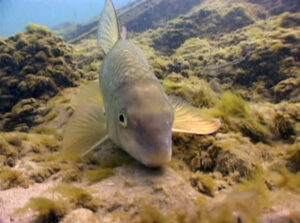
Hog Sucker from the front. (Photo Credit: Greg Lashbrook/PolkaDot Perch)
Bad Rap
William Shakespeare famously addressed his own question, ‘what’s in a name?’ by noting ‘a rose by any other name would smell as sweet.’
So, if you rename a rose something else like ‘toilet’ it will still smell like a rose. But if I can’t see it and you ask me to sniff the ‘toilet’ I’d resist even though if I did sniff, I’d discover that it does smell like a sweet rose.
Labels don’t change the physical properties of something, but words can and do significantly influence human perceptions.
In the case of the fish, being labeled a sucker does them no favors.
The most common use of the word sucker refers to an easily deceived person. In other words, a chump, patsy or sap. This usage evolved from the idea that someone was as naïve as an unweaned baby or suckling. This likely explains why I’ve never met anyone who aspires to be a sucker.
Sadly, simply by word association, a lot of people hold a fairly low opinion of suckers.
Additionally, bottom-feeding species are often shunned by fishers as being “dirty” and undesirable. The irony is that suckers actually benefit from being near the bottom rung of the fishing ladder by not being targeted.
In the way of the bard, I wonder — if a sucker were called a lollipop fish would it taste any sweeter?
Catch more news at Great Lakes Now:
I Speak for the Fish: Searching for the elusive sculpin
I Speak for the Fish – What’s the most popular freshwater fish?
Featured image: Hogsucker (Photo Credit: Greg Lashbrook/PolkaDot Perch)


